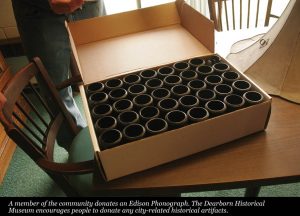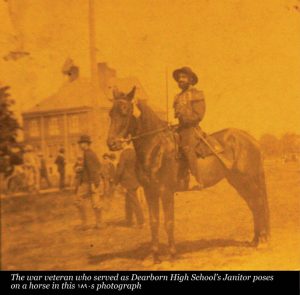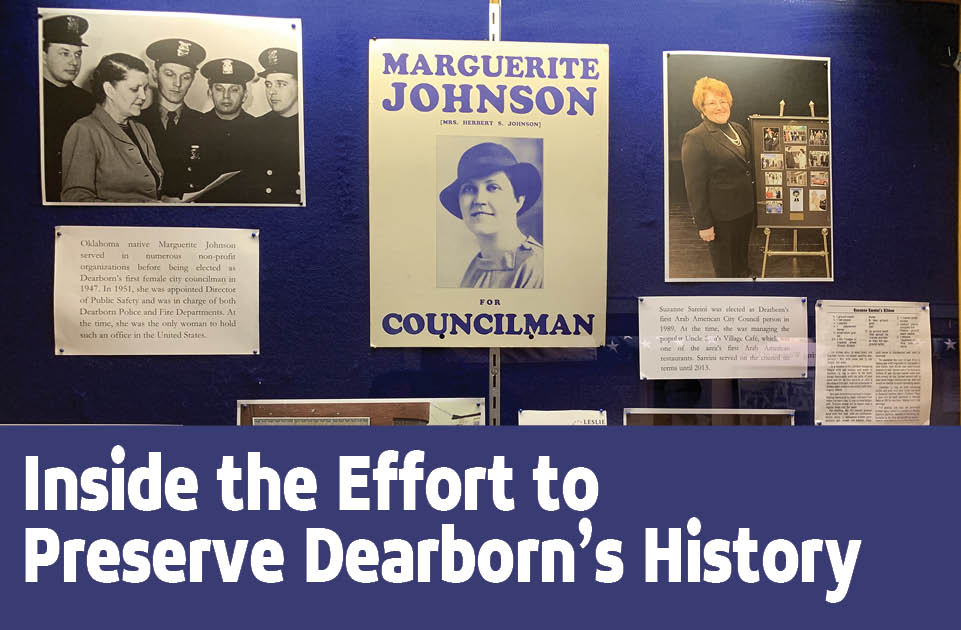By Simon Albaugh – YAN- Hamtramck



In a long hallway of filing cabinets and records that stretch multiple rooms, an army of volunteers catalogs the millions of photos, documents, maps and artifacts that comprise the vast collection of Dearborn’s Historical Museum.
Spanning multiple buildings and a full-time effort to organize, it’s the most important collection of Dearborn’s history.
One of the Museum’s staff, the Dearborn Historical Museum’s Archivist, Mason Christensen, dons white gloves and with a gentle grip pulls a photo from one of the filing cabinets. “It’s a personal favorite of mine, this image,” Christensen says.
The photo he pulls out is a bearded man posing on his horse.
“What this is here is the original Dearborn High School,” Christenson says. “This guy’s a retired Veteran and he lost an arm due to an accident. But he served as the Dearborn Public Schools Janitor in the 1890s.”
Dearborn has a long and expansive history. Stretching back to the 1830s, the town was a military base used for defending the budding Michigan territory from the threat of a British Invasion. The fort stretched along what is now Downtown West Dearborn. In fact, the Historical Museum’s main building is the very same one used to store the Fort’s gunpowder.
Mason said there were never any invasions from a British-Canadian Military. Instead, the Fort was used for battles with Native Americans when the United States violently expanded West. As the buildings aged and changed purposes, the gunpowder storage became a farmhouse before being donated to the Museum.
Throughout its history, Dearborn’s borders had a strange way of shifting and growing. What used to be the Fordson and Greenfield communities was swallowed by an awkward expansion that left town leadership in flux.
Despite the changes, all of Wayne County participates in a broader regional history. The artifacts, research and even the events are shared among the major historical institutions throughout the area. The Detroit Historical Museum, Henry Ford Museum and even the Arab American National Museum have all collaborated with the Dearborn Historical Museum.
“We love to be more involved with local institutions,” says Assistant Chief Curator Paul Talpos. “We love finding ways of collaborating and loaning items to each other or building exhibits and programs together.”
In a way, they’re all tied together by the common goal of presenting history to those curious about the places where they live. And according to Mason Christensen, there’s something for everyone to find a connection with, like the open archives that can be accessed by anyone who’s wondering about their city’s history.
Because Dearborn’s history had a major impact on the region as a whole. Henry Ford, the manufacturing behemoth who brought most of America into the automobile age, was born in Dearborn. His factories attracted people from all around the world for high-paying jobs.
People from as far away as Lebanon arrived to work in Ford’s factories. “And that’s why the first Mosque in the United States was established in Highland Park,” Christensen said. But when plants closed, the Lebanese population moved to be near Dearborn’s Rouge Plant, establishing what would become the most notable Arab-American centers in the United States.
However the museum has shifted its focus in the past few years. Looking for a better relationship with the city, Dearborn Historical Museum has amped-up its outreach to make the audiences know that this is their museum.
“Our goal as a museum and as a staff is always to improve our relationship and reach out to new audiences,” Loren Harvey said. “So I think that we’re definitely trying to tell stories of people that haven’t been told before.”
But at the beginning of each day, the museum’s first job is to present the history. Whether it’s for the best or for the worse. “We try to be open,” Christensen said. “You know, every city has ugly aspects. But part of a city is helping people figure out what the city’s problems are.”
The people of Dearborn have a museum that’s constantly evolving. From the ongoing renovations to create a historically-accurate reconstruction of the farmhouse that the museum once was, to the expansive collection of objects. This is all of Dearborn’s history.
“The broader Dearborn is here because of our history,” said Curator Jack Tate. “And that’s what we’re trying to show. How we got where we are. What are the circumstances that brought us where we are today. All this put together, that’s what Dearborn is today.”












